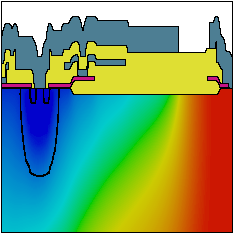WIAS-TeSCA
Modeling and Simulation of Semiconductor Devices

Product
WIAS-TeSCA (Two-dimensional semiconductor analysis package) is a program system for the numerical simulation of charge transfer processes in semiconductor structures, especially also in semiconductor lasers. It is based on the drift-diffusion model and considers a multitude of additional physical effects, like optical radiation, temperature influences and the kinetics of deep (trapped) impurities. Its efficiency is based on the analytic study of the strongly nonlinear system of partial differential equations (van Roosbroeck), which describes the electron and hole currents. Very efficient numerical procedures for both the stationary and transient simulation have been implemented in WIAS-TeSCA.
Fields of Application
WIAS-TeSCA has been successfully used in the research and industrial development of new electronic and optoelectronic semiconductor devices such as transistors, diodes, sensors, detectors and lasers and has already proved its worth many times in the planning and optimization of these devices. WIAS-TeSCA covers a broad spectrum of applications, from hetero-bipolar transistor (mobile telephone systems, computer networks) through high-voltage transistors (power electronics) and semiconductor laser diodes (fiber optic communication systems, medical technology) to radiation detectors (space research, high energy physics).
Key Features
- Treatment of arbitrarily-shaped two-dimensional structures by the finite element method
- Consideration of hetero effects for layers of different materials
- Wide model choice
- Very reliable simulation results due to a mathematically exact transformation the (physical) balance equations on the approximation grids
- High-performance numerics for stationary and transient simulations
- High stability and high-speed computing
- WIAS-TeSCA is available for UNIX workstations and Linux PCs
Key Benefits
WIAS-TeSCA is an efficient simulation tool for analyzing and designing modern semiconductor devices with a broad range of performance that has proved successful in solving many practical problems. Particularly, it offers the possibility to calculate self-consistently the interplay of electronic, optical and thermic effects. WIAS-TeSCA stands out for its high flexibility. It is used especially for problems where expensive and time consuming experiments and conventional simulation software find their limits.
Service
- Individual user consultations
- Joint search for solutions and performance of ordered calculations with obtained user input
- Software installation and support
- Model adaption and implementation of models conforming to customers' requirements
Contact
Phone, E-mail
Tel.: 030 20372-442
E-mail: tesca@wias-berlin.de
WIAS Software (Archive)
- awc - Adaptive weights clustering
- BOP - A Simulator for Large-Scale Process Engineering Problems
- ClusCorr98 ® for exploratory data analysis
- DiPoG - Direct and Inverse Problems for Optical Gratings
- gltools for interactive or non-interactive graphical output
- WIAS-MeFreSim - 3D-Simulation of Multifrequency Induction Hardening
- ParMooN - Mathematics and object-oriented Numerics
- WIAS-QW for the simulation of strained multi quantum well structures
- S/PHI/nX library for materials simulation
- WIAS-TeSCA for two and three dimensional semi-conductor analysis


